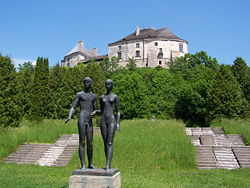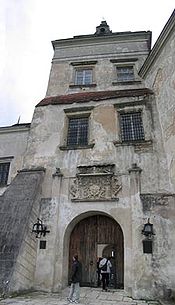- Olesko Castle
-
Coordinates: 49°59′03″N 24°40′53″E / 49.984043°N 24.681270°E
Olesko Castle Olesko, Lviv Oblast, Ukraine
The Olesko Castle in Ukraine.Type Castle Built 14th century Current
conditionSurvives in good condition. The Olesko Castle (Ukrainian: Олеський замок) is currently located within the borders of the present-day Busk Raion in Ukraine. The first historical records of the castle are in a document dated 1390, when Pope Boniface IX gave Halych, a Catholic bishop, this castle as a gift. It is located about seventy-five kilometers from Lviv, the largest city in western Ukraine.
Contents
Location
The Olesko Castle, oval in shape, stands on top of a small hill, about fifty meters in height. A moat and a wall surrounds it, which serves as a defence for the castle. The castle is also surrounded by a dense swamp. The land that the castle sat on changed ownership many times. It was originally on the border of land of Volhynia and land of Lviv.
The castle was, at different times, owned by Poland, Lithuania, and Hungary. It became a political landmark in the 14th century when movable borders between the three aforementioned countries ran through its territory. Battles for ownership of the castle were constant. A deep well in the basement of the castle was used as an escape route for besieged prisoners.
Inhabitants
In the 15th century, the castle was changed from being a defense point, to simply a getaway for aristocracy.
In 1605, the castle was bought by Ivan Danylovych (in Pol. Jan Daniłowicz h. Sas), a rich local landowner, Voivode of the Ruthenian Voivodeship. It was then sold to the family of Koniecpolski. The new owners, whose main residence was in Zolkiew, treated the castle poorly, and only in 1682 the castle was renovated by Jan III Sobieski, who bought the complex from Stanislaw Koniecpolski for 400 000 zlotys. In early 18th century, Olesko was bought by the family of Rzewuski, and its collection of antiques was moved to another castle the Rzewuscy owned, the Pidhirtsi Castle.
The castle is perhaps most famous for being the birthplace of the Polish king Jan III Sobieski, the hero of the Battle of Vienna. He often lived there, and collected many of the artworks currently displayed in the present-day museum. Another Polish king, King Michał Korybut Wiśniowiecki, was also born here.[citation needed]
Restorations
The castle was restored in the late 16th to the early 17th Centuries. Paintings and mosaics were brought in to decorate the different rooms of the castle. The castle was remodeled in the Italian Renaissance style, which was popular at that time.
In 1838, an earthquake rocked the castle, partly destroying some areas. In 1882, the castle, regarded as a Polish national monument was bought by the Committee of Preservation of the Olesko Castle, which led to a restoration in 1892. Both World War I and World War II affected the castle negatively, undoing previous restoration work. In 1956, the castle was struck by lightning.
The castle was restored again, beginning in 1961 and lasting until 1985. Today, it is a museum, displaying the collections of antique furnishings and art dating from the 16th-17th Centuries. It also features sculptures, paintings, still lives, applied arts, tapestries, period weapons, and objects used in everyday life at the time. Its collection is regarded as one of the richest treasury of Polish art outside borders of Poland.
The castle is a part of the "Golden Horseshoe", a ring of three castles nearby each other: the Olesko, the Pidhirtsi, and the Zolochiv Castles.
See also
References
- Castles.org - Olesko Castle
- lvivecotour.com - Olesko Castle Tour in English]
- MyUkraine
- UNAREC Ukraine
Polish-Lithuanian Castles and Forts in the Kresy  Black RutheniaSurviving
Black RutheniaSurvivingOld Grodno • New Grodno • Lida • Mir • Nieśwież • Dwór Stanisławów RuinedGieraniony • Holszany • Krewo • Lubcz • Nowogródek • Różana  Volynia
Volynia GaliciaSurviving
GaliciaSurvivingBrzeżany • Olesko • Podhorce • Pomorzany • Stare Sioło • Świrz • Tarnopol • Wiśniowiec • Zbaraż • Potok Złoty • Złoczów • Żółkiew Ruined PodoliaSurviving
PodoliaSurvivingKamieniec Podolski • Latyczów • Międzybuż • Satanów RuinedBusza • Czarnokozińce • Kudryńce • Okopy Świętej Trójcy • Sidorów • Zinków • Żwaniec External Links
Categories:- Castles in Ukraine
- Royal residences in Ukraine
- Lviv Oblast
Wikimedia Foundation. 2010.



